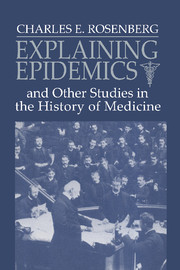Book contents
- Frontmatter
- Contents
- Acknowledgments
- Introduction: Why care about the history of medicine?
- I Ideas as actors
- II Institutions and medical care
- 7 The practice of medicine in New York a century ago
- 8 Social class and medical care in nineteenth-century America: The rise and fall of the dispensary
- 9 From almshouse to hospital: The shaping of Philadelphia General Hospital
- 10 Making it in urban medicine: A career in the age of scientific medicine
- III The past in the present: Using medical history
- Index
10 - Making it in urban medicine: A career in the age of scientific medicine
Published online by Cambridge University Press: 29 March 2010
- Frontmatter
- Contents
- Acknowledgments
- Introduction: Why care about the history of medicine?
- I Ideas as actors
- II Institutions and medical care
- 7 The practice of medicine in New York a century ago
- 8 Social class and medical care in nineteenth-century America: The rise and fall of the dispensary
- 9 From almshouse to hospital: The shaping of Philadelphia General Hospital
- 10 Making it in urban medicine: A career in the age of scientific medicine
- III The past in the present: Using medical history
- Index
Summary
The three previous chapters, respectively on medicine in New York in 1866, the rise and fall of the dispensary, and Philadelphia's General Hospital, focus on the institutional fabric of urban medicine, one emphasizing interrelationships at a particular moment in time, the other two following institutions across time. This essay looks at the same urban setting, but employs a very different analytical strategy. It attempts to reconstruct that professional setting in terms of specific choices as perceived by a contemporary actor seeking to make his way among them. I wrote it partially because of an accident: my stumbling upon the extraordinary – and atypical – correspondence on which it is based; the letters were simply too rich and circumstantial to be ignored. But I also wrote it with the more general intent of demonstrating the relevance of biography to social and cultural history. I had heard too many comments from academic historians disparaging the conceptual deficiences of biography and the narrow vision of its practitioners. I have always thought very positively about biography and never felt that there was a necessary contradiction between the writing of an individual life and history generally. Quite the contrary in fact; a life can be construed as a sampling device – as a controlled and internally coherent batch of data, a chronologically ordered set of realities and relationships as perceived and understood by a particular actor. Biography, like the aggregated data of the historical demographer or student of voting behavior, constitutes an indispensable tool for the collective historical enterprise.
- Type
- Chapter
- Information
- Explaining Epidemics , pp. 215 - 242Publisher: Cambridge University PressPrint publication year: 1992



